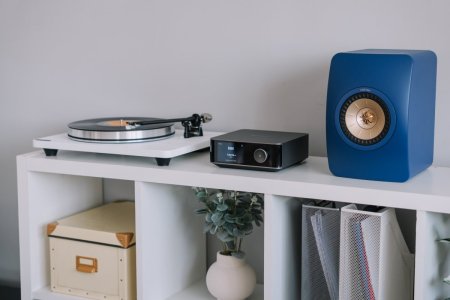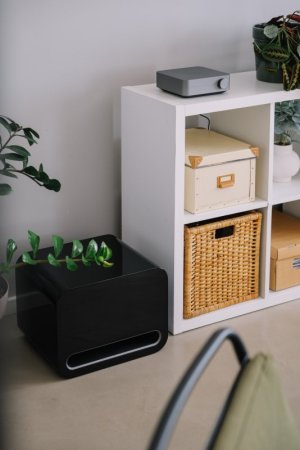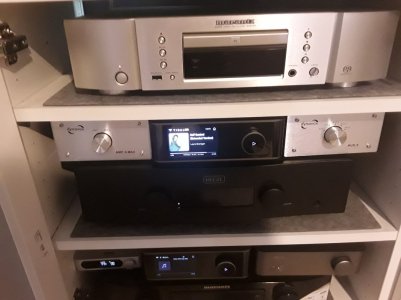
We’re thrilled to introduce our most refined streaming amplifier yet, the WiiM Amp Ultra, a high-performance powerhouse built for discerning listeners. Encased in a sleek unibody aluminum chassis with a vibrant 3.5” glass touchscreen, it delivers 100W per channel at 8Ω or 200W at 4Ω, driving up to four passive speakers with stunning clarity and dynamics.Built with audiophile-grade components, including the ESS ES9039Q2M SABRE DAC, dual TI TPA3255 amp chips, and six TI OPA1612 op-amps, Amp Ultra ensures ultra-low distortion and rich, detailed sound. Post Filter Feedback (PFFB) technology further enhances load-independent performance across all speaker types, delivering cleaner sound and improved amplifier control, especially for complex loads.
Key Features
- Powerful Amplification
- Delivers 100W per channel at 8Ω or 200W at 4Ω—easily drives up to four passive speakers with stunning clarity and dynamics.
- Audiophile-Grade Components
- Features the 32-bit/384kHz ESS ES9039Q2M SABRE DAC, dual TI TPA3255 Class-D amp chips, and six TI OPA1612 op-amps for ultra-low distortion and rich, detailed sound.
- Post Filter Feedback (PFFB) Technology
- Ensures stable, load-independent performance across all speaker types—delivering cleaner sound and improved amplifier control, especially with complex loads.
- Next-Gen Connectivity
- Equipped with Wi-Fi 6E, Bluetooth 5.3 with LE Audio, and dual antennas for fast, stable streaming across all wireless protocols.
- Elegant Touchscreen Design
- Housed in a premium unibody aluminum chassis with a vibrant 3.5” glass-covered touchscreen for intuitive control and stunning aesthetics.
- RoomFit Room Calibration Built-In
- Advanced room correction technology analyzes your space and customizes output for speakers and subwoofer to optimize soundstage and tonal balance.
- Exceptional Sound Performance
- Achieves -105 dB THD+N and 120 dB SNR at 5W—ideal for high-fidelity playback across any genre or setup.
- All-in-One Streaming Hub
- Stream music, podcasts, audiobooks, and internet radio in Hi-Res up to 24-bit/192kHz directly to your speaker system.
- Universal Music Service Support
- Seamless access to Spotify, Amazon Music, TIDAL, Qobuz, Deezer, Pandora, iHeartRadio, TuneIn, and more via the WiiM Home App.
- Cast with Ease
- Supports Google Cast, Alexa Cast, DLNA, Spotify Connect, TIDAL Connect, DLNA, and Roon (certification pending) for effortless playback from your favorite apps.
- Flexible Input Options
- Connect turntables, TVs, or other sources and broadcast audio wirelessly across your multi-room system.
- Cinematic TV Audio
- HDMI ARC, Dolby Digital decoding, and dedicated subwoofer output bring immersive home theater sound to your living room.
- Smart Voice Control
- Works with Alexa, Google Assistant, and the WiiM Voice Remote for hands-free playback and system control.
- Customizable EQ
- Fine-tune your audio with parametric and graphic EQs tailored to your own preference.
- Future-Proof Experience
- Receive ongoing firmware updates with new features, services, and performance enhancements.
- Home Theater Integration:
- Functions as the front, surround or center channel speaker in a Dolby 5.1 setup
- Smart Preset
- Streamlines the listening experience by offering quick access to frequently used content and settings.
- Alarm Clock
- Set the alarm time, occurrence, and choose from various music sources.
Versatile Connectivity & Streaming
Amp Ultra integrates seamlessly into stereo setups and home theaters. With Wi-Fi 6E, Bluetooth 5.3 with LE Audio, and HDMI ARC with Dolby Digital decoding, it adapts to both wireless and wired configurations, making it perfect for immersive entertainment.Streaming is effortless with Spotify, Amazon Music, TIDAL, Qobuz, Deezer, Pandora, iHeartRadio, TuneIn, and more via the WiiM Home App. Users can cast audio from their favorite platforms, including Google Cast, Alexa Cast, DLNA, Spotify Connect, TIDAL Connect, and Roon, ensuring seamless playback across devices.
Smart Home Audio Control
With multi-room sync, automatic room calibration, and customizable EQ settings, Amp Ultra ensures tailored sound across any space. The WiiM Home App, Alexa, Google Assistant, and the WiiM Voice Remote 2 provide effortless control over playback, sound tuning, and system settings.A 3.5” glass-covered capacitive touchscreen allows users to directly adjust playback, browse album art, access EQ settings, switch inputs, and view their queue, with additional features like VU meters, presets, and custom wallpapers to personalize the listening experience.
Designed for Cinematic & High-Fidelity Listening
Amp Ultra takes home entertainment to another level. HDMI ARC, Dolby Digital support, and a dedicated subwoofer output transform movies into cinematic experiences, while home theater integration allows it to function as a front or surround speakers in a Dolby 5.1 setup.Its precision-machined unibody aluminum build enhances durability while maintaining a modern, sophisticated aesthetic, measuring 7.9” x 2.9” x 7.9” and weighing 5.4 lbs.
Future-Proof & Always Improving
Regular firmware updates will introduce new features, services, and performance enhancements, keeping Amp Ultra at the leading edge of streaming amplification.Pricing & Availability
WiiM Amp Ultra, bundled with the WiiM Voice Remote 2, will be available Q3 2025 on Amazon and select retail partners. Stay tuned for pricing details, we'll announce them when the product becomes available. For more details, visit www.wiimhome.com.Attachments
Last edited by a moderator:




